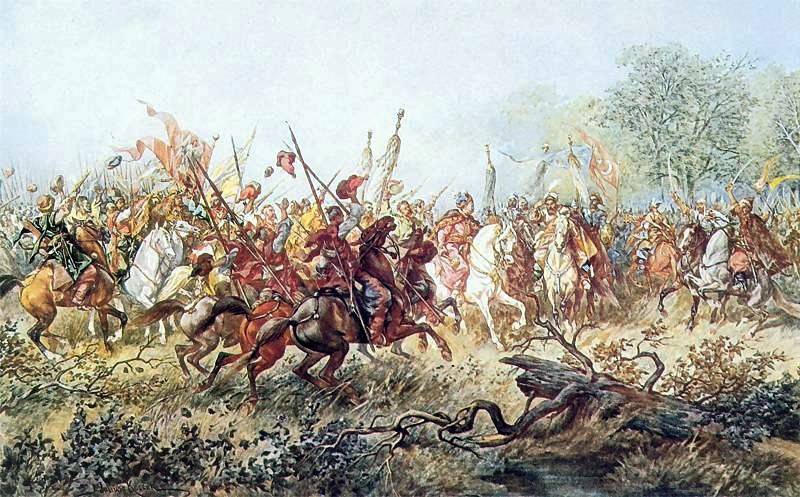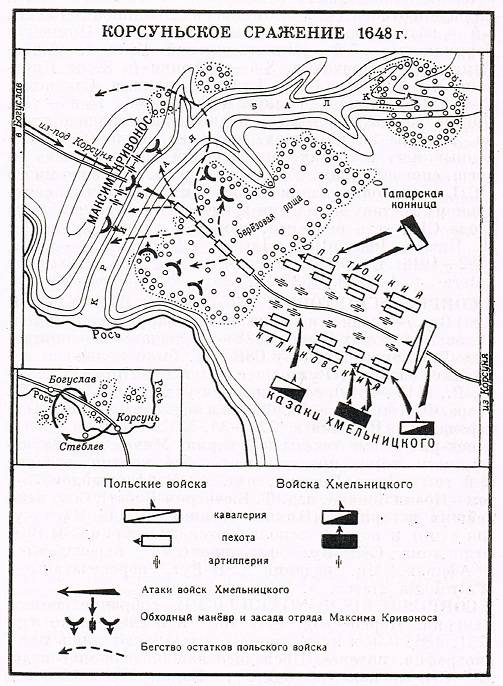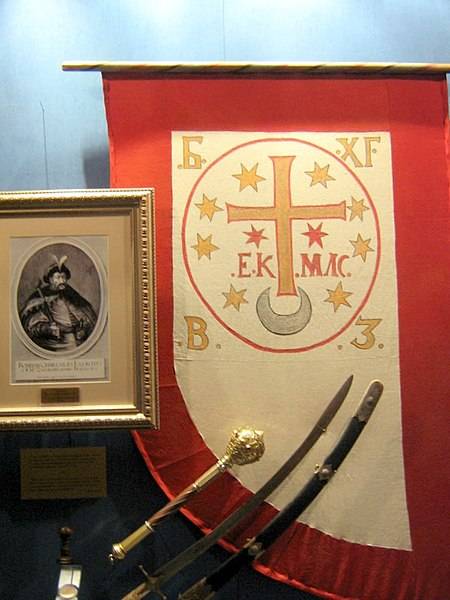Potocki's army catastrophe near Korsun

Juliusz Kossak, Meeting of Tugai Bey and Khmelnitsky near Korsun
Continuation of hostilities
Unaware of the defeat of his vanguard (Battle of Yellow Waters), the crown army of the hetmans Pototsky and Kalinovsky continued to go south. The large army moved slowly. It seemed that this was not a hike, but a pleasure walk. Each magnate and pan came not only with his banner squad, but also with wagons, where everything was available for feasts. Nobody thought about the war. Pans tripled feasts and feasts, boasted of wealth in front of each other. With whom to fight something? With a bunch of nerds? And they are one of the best armies in Europe.
On May 3, 1648, Polish troops slowly passed Chigirin and pitched the camp. More than 100 versts are left to Zhovti Vody. Soon came the news of the defeat of the vanguard. The pans were stunned with surprise. The enraged crown hetman Potocki, who lost his son in the battle of Zhovti Vody, ordered the surrounding villages to be burned. The army went further, on May 10, the Poles arrived near Korsun and took up a strong position. Fortified with chances, ditches and put batteries. On one side the camp was covered by the river Ros. The crown army numbered from 14 to 25 thousand people with 40 guns.
After the defeat of the Polish forces near Zhovti Vody, the Cossacks, reinforced by registered regiments that went over to the side of the rebels, decided to oppose Pototsky's army. 2 hunters (volunteers) arrived from Chigirin, Krylov, and other towns and villages. Khmelnitsky organized an army. He subordinated the artillery and convoy to the general convoy Sulima, and placed Nebaba over the Cossack Cossacks. He divided the registered Cossacks into six regiments - Chigirinsky, Cherkassky, Korsunsky, Kanevsky, Belotserkovsky and Pereyaslavsky. Krivonos, Bohun, Charnota, Nechay, Mozyr and Veshnyak became colonels. Teterya was appointed general captain.
Khmelnytsky's army, according to various estimates, numbered 15-20 thousand people. Mostly infantry. The Crimean horde of Tugai Bey also increased to 4-6 thousand people (according to other sources, clearly overestimated, 20 thousand). Khmelnitsky was well aware of the position of the Polish army. Information came from numerous supporters in Potocki's camp.
On May 14 (24), the Cossack hetman sent forward the regiment of Krivonos and part of the Crimeans. In the evening, this regiment began to operate behind Rosya, in the rear of Pototsky. Near Steblev, the Cossacks of Krivonos blocked the Ros River to facilitate access to the Polish camp. At dawn on May 15 (25) the main Cossack-Crimean army approached the Korsun region and crossed the Ros, stopping in Korsun. The first skirmishes began. The city burned down.
Military trick
Cautious Khmelnitsky did not want to storm a well-fortified enemy position with a strong army. This could lead to heavy losses even in case of victory, or to failure. Therefore, the Cossacks used a military trick. One of the Cossacks agreed to voluntarily sacrifice himself. During the skirmish, he was deliberately captured. He died under torture and told the Poles that there were no number of Cossacks, Tugai Bey had 50 thousand horsemen, and soon there would be the entire Crimean horde.
The Poles were alarmed, disputes began about what to do next. They feared not only the forces of the Cossacks and Tatars, but also the siege and hunger. Late in the evening of May 15, a council of war was held. Kalinovsky and some other experienced commanders offered to stand in a strong position, build new fortifications and wait for reinforcements. The majority, led by Potocki, decided to retreat and link up with Vishnevetsky's troops. A messenger arrived from a powerful prince and said that he was coming to the rescue with 6 troops.
On the night of May 16, intelligence reported to Khmelnitsky about the preparations in the enemy camp. Cossack scout Samoilo Zarudny, who, on behalf of the hetman, acted as a conductor of the Polish troops, spoke about the plans of the enemy. The Poles decided, leaving most of the carts, to go light through Bohuslav and Bila Tserkva to Pavoloch. On the path of the gentry, 10 miles from Korsun, there was a narrow forest valley - the Gorokhovaya Dubrava gully (or Krutaya, Krivaya Balka). The road here went through a narrow swampy ravine, passed through two heights, the slopes of which were overgrown with oak forests. The rugged terrain did not allow the pans to use the advantage in the armored cavalry.
Khmelnitsky decided to intercept the enemy in this place. He sent 6 thousand Cossacks with artillery led by Krivonos to intercept communications. They set up an ambush in Krivoy Balka. The road was dug up with ditches, on the road and roadsides they made notches from fallen trees. Prepared positions for guns and infantry.

Battle
At dawn on May 16 (26), 1648, a large column of Polish troops began to retreat along the Boguslav road. Cavalry was in the forefront and rearguard, in the center was a convoy with ammunition and especially valuable property, artillery, and on the flanks - infantry. At first, the Cossacks and Tatars did not interfere with the Poles. Then they began to accompany, put pressure on the rear and flanks.
With a quick march, the crown army reached the Gorokhovaya Dubrava and went down at noon. Here the gentry had to change their marching order, stretching along a narrow road. Suddenly, Cossack cannons began to fire from the bushes. The rough terrain and the forest prevented the gentry from using the cavalry and pushing the enemy back. While the Polish soldiers made their way through the forest, dismantled the rubble, paved the way, they were shot from cannons and muskets. The guns got stuck in the swamp, and the artillery became useless. The wagons also got stuck, they were attacked by the Cossacks and Crimeans. While the Polish avant-garde was trying to break forward, the rest were trying to find a way out of the Yar, turned back. But there was no salvation.
The main forces of Khmelnitsky and Tugay Bey also entered the battle. Potocki, seeing that his army was dying, made a last attempt to break through. He ordered the mounted banners to dismount and take up their muskets. But the Polish cavalry, not accustomed to foot combat, failed to reorganize in time and create a dense defensive order. Cossacks and Tatars broke into the Polish camp. The panic began. Polish servants, servants seized horses, from which the owners dismounted and tried to escape.
For some time, Polish soldiers fought back in the center, but soon he fell too. Panic has become general. The soldiers fled, trying to escape as best they could. The Tatars cut them or knitted them for sale. Only Prince Koretsky was able to break through with his squad, losing half of the two thousandth detachment in battle. In four hours of battle, the Polish army was gone. Cossacks and Crimeans captured rich booty. All convoy and artillery. Both Polish hetmans, dozens of prominent magnates and pans, more than 8 thousand soldiers were taken prisoner. The captives were immediately sent to the Crimea. The rest of the army was killed. Only about 1,5 thousand people were able to escape.
The defeat of the gentry army near Korsun had decisive consequences. The Poles lost the main armed force in Little Rus'. Detachments of Vishnevetsky and other magnates, having learned about the death of the crown army, retreated to their possessions or, taking their families, fled to the borders of Poland. Polish officials from the Kyiv and Bratslav provinces flee to Lithuania. The Korsun pogrom was the signal for a general uprising. Peasant riots flare up everywhere, Polish gentry estates are smashed and burned. Riots began even in Galicia, which was far from the center of the uprising. In the cities, the burghers and local villagers smash the Polish and Jewish communities, Catholic monasteries and churches.
The uprising of the Cossacks grew into a people's Russian liberation war. King Vladislav IV died 6 days before the Battle of Korsun, and a period of kinglessness began in the Commonwealth. That is, favorable conditions appeared for the development of the offensive.
At the Korsun Rada on May 18, the Cossacks decided to continue the war with the gentry, decided to ask the Russian Tsar for military assistance and reunification with Russia. On May 22, Bila Tserkva solemnly welcomed the army of liberators.

Information